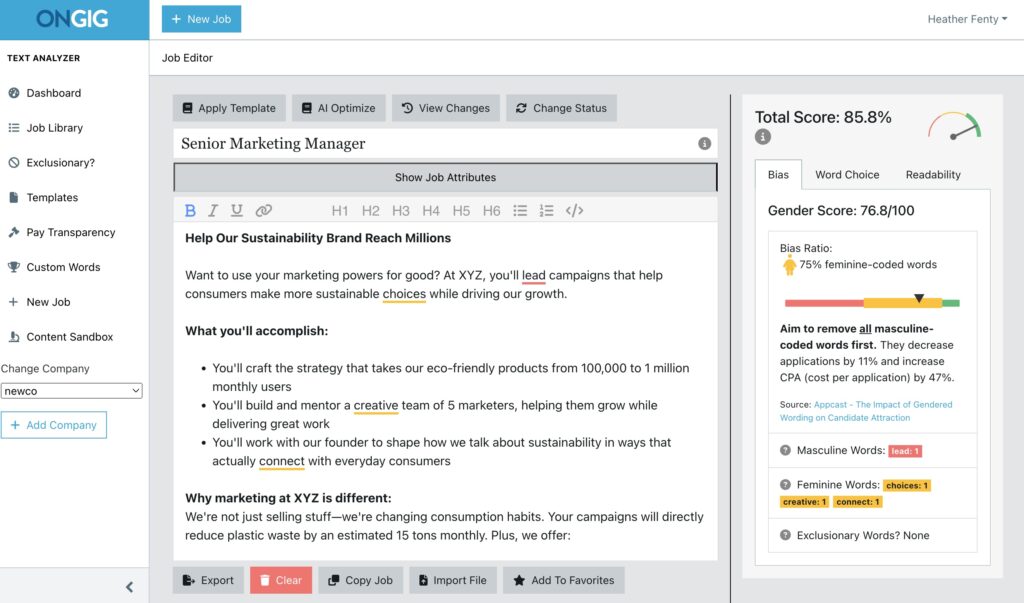- Lessons in Leadership and Language: A Conversation with Kat Kibben - October 28, 2025
- What LinkedIn’s Latest AI Features Say About the Real Work Recruiters Are Doing - October 23, 2025
- Custom Job Post Workflows: How One Insurance Client Improved JD Approvals - October 21, 2025
If you’ve ever worried that your job descriptions might quietly turn great candidates away, without even realizing it, you’re not alone. Writing fair and inclusive job descriptions in Canada takes more than just good intentions.
With such a diverse workforce — including newcomers, people with disabilities, Indigenous communities, and bilingual speakers — it’s important to think carefully about the words you use.
I’ve worked on job ads that looked totally fine… but were actually packed with subtle bias. The kind that makes women, older workers, racialized folks, or people with disabilities scroll right past.
In Canada, inclusive hiring isn’t just a value — it’s also a movement.

Why Inclusive Language Matters in Your Job Descriptions in Canada
Job Descriptions in Canada: Canada is Built on Diversity
Canada is one of the most diverse countries in the world. People here come from many different backgrounds, speak different languages, and bring a wide range of experiences to the workplace.
That’s why using inclusive language in your job descriptions is so important. It helps everyone feel welcome, no matter their gender, age, ability, culture, or where they were born.
It’s About More Than Just Being Nice
Inclusive language isn’t just a “nice to have.” In Canada, it’s also the law in many cases.
If your company falls under the Employment Equity Act, you’re expected to remove barriers that make it harder for certain groups to apply, especially women, Indigenous peoples, persons with disabilities, and members of visible minorities.
In Ontario, the Accessibility for Ontarians with Disabilities Act (AODA) requires businesses to make hiring accessible, including the language used in job ads. And across the country, Human Rights Codes protect people from discrimination in employment.
It’s the Right Thing to Do
Beyond the legal side, there’s also a moral one. So, writing job ads that are clear, fair, and welcoming helps build a stronger, more equal workplace.
As diversity expert Dr. Malinda S. Smith said:
“It’s not about whether people have goodwill; it’s about whether people have the skills to recognize the importance of why this is the right thing to do. Why it’s also going to be to our disadvantage to exclude from full participation the great complexity of Canadian society.”
When your words reflect that, your hiring process gets better for everyone.
So let’s fix those biased job descriptions, one line at a time.
1. Write Like a Human, Not a Checklist
The easiest way to remove bias? Stop writing like you’re talking to a robot. You’re talking to a person, not submitting paperwork to HR. Long, formal sentences full of jargon don’t sound impressive — they sound cold.
Here’s what I do instead:
- Use “you” instead of “the candidate.”
- Drop passive voice.
- Avoid overstuffed words like “leverage,” “synergy,” or “best-in-class”.
Plain language is inclusive language.
2. Watch Out for Gender-Coded Words
In Canada, gender bias is still baked into a lot of job ads. Words like “competitive,” “assertive,” or “strong leader” tend to attract more men. Words like “supportive” or “nurturing” often pull in more women. Neither is wrong — but it depends on the role.
If you want balance, mix your language. Try to get to neutral for best results.
3. Drop Age or Ability Bias
Skip phrases like:
- “Digital native” (excludes older talent)
- “Must be able to lift 50 lbs” (unless it’s essential)
- “Recent graduate” (filters out experienced folks unfairly)
Even saying “energetic” can imply you’re looking for a younger person. So, swap it with “self-motivated” or “adaptable” if that’s what you really mean.
4. Be Specific, Not Exclusive
If you list 10 must-haves for a role, you’ll lose qualified people who don’t check every box. That’s especially true for women, Indigenous applicants, people of colour, and newcomers to Canada.
Stick to 3–5 actual requirements (7 max, if you have to). Put everything else in a “nice to have” section.
Real Example: Biased vs. Bias-Free
Here’s a quick before/after you can use as a reference for unbiased job descriptions in Canada:
Biased vs. Inclusive Job Description Examples
| Bias Type | Biased Version | Inclusive Fix |
|---|---|---|
| Gender Bias | We’re looking for a strong leader who can dominate the market | We’re looking for a skilled team member who can grow our market reach |
| Age Bias | Perfect for recent grads hungry to prove themselves | Open to candidates early in their careers who are eager to learn |
| Ability Bias | Must be able to lift 50 lbs | Role may involve moving boxes occasionally (accommodations available) |
| Overqualified Filter | Must have 10 years of experience in a startup | Experience in similar industry is a solid asset |
| Education Bias | Degree from Ivy League or top-tier school required | Relevant education or equivalent experience valued |
| Language Bias | Fluent in English without an accent | Strong spoken and written communication in English is required |
| Cultural Bias | Must have Canadian experience | Willingness to adapt to a Canadian workplace culture is valued |
Job Descriptions in Canada: Avoiding Bias in Salary & Benefits Language

Vague Salary Phrases Can Hurt Your Chances
When you say things like “competitive salary,” it might sound good, but it’s actually pretty unclear. Candidates, especially those from marginalized groups, may feel unsure if the pay is fair or worth their time. This can make them skip applying altogether.
Salary Transparency Supports Fairness
In Canada, some provinces like British Columbia and Ontario are starting to require employers to be open about pay. So, sharing a salary range right in the job ad helps everyone know what to expect. It also shows you value fairness and want to attract the right people, not just those willing to guess or negotiate hard.
Don’t Forget Inclusive Benefits
Salary is important, but benefits matter too. So, make sure your job description talks about benefits that support all kinds of people. For example:
- Parental leave is available to all genders
- Mental health resources and counseling
- Flexible hours for caregiving or religious practices
- Culturally sensitive support programs
When you include these, candidates can see that you care about their whole life, not just the work they do.
Clear Pay and Benefits Language Welcomes Everyone
Being open and specific about salary and benefits also helps you remove uncertainty and invite a wider range of applicants. It’s a small change that makes a big difference in creating an inclusive hiring process.
Intersectionality: Why One Fix Doesn’t Fit All

Bias Doesn’t Happen in a Bubble
It’s important to remember that people have more than one identity. A job ad might affect a Black woman with a disability differently than it would a white newcomer. Bias isn’t just about one thing — it can show up in many ways at once.
Think About the Whole Person
That’s why one quick fix won’t cover everything. You need to layer your inclusive practices. For example, using plain language helps newcomers and people with lower literacy levels. But if you also follow accessibility best practices, like using clear headings and alt text, you support people with disabilities too.
Layering Makes a Bigger Impact
The more thoughtful you are, the more people you’ll reach. So, try combining:
- Plain, easy-to-read language
- A diversity-friendly tone (warm, respectful, human)
- Accessibility features (like screen reader-friendly formatting)
This kind of layered approach also shows that your company is ready to welcome everyone, not just the majority.
Job Descriptions in Canada: Do a Bias Check Before You Post
Once you’ve written your job ad, take a moment to test it. A quick check can help you catch biases you might have missed.
Try This Quick Self-Test
Read your job description and ask yourself:
- Would someone over 50 feel like they belong on your team?
- Would indigenous applicants want to apply?
- Could a parent returning to work see themselves in this role?
- Would someone from the LGBTQ+ community feel like they fit in?
- Would a person with a disability feel welcome to apply?
If you answer “maybe” or “no” to any of these, go back and revise the wording. Small changes can make a big difference.
It’s a Simple Step — But a Powerful One
This test only takes a few minutes, but it helps make your job posting more inclusive for more people.
How Ongig Helps You Remove All Bias From Your Job Descriptions in Canada (Automatically)

You don’t need to catch all this bias on your own. I use Ongig’s Text Analyzer to do the dirty work.
So, here’s how it works for Canada-based teams:
- Canadian English & Local Bias Flags: It picks up terms like “stakeholders” or “recent grad” — even subtle phrases that break Employment Equity rules.
- AI-Powered Rewrite Suggestions: You get inclusive wording suggestions in real time, backed by research (not just gut feel).
- Job Description Templates: Create and reuse bias-free templates across teams so you don’t have to start from scratch every time.
And yes — it works in English, but edited job descriptions can be exported in French if you need it.
Want to see a quick demo? Here’s a quick look at how Ongig removes bias from job descriptions.
Job Descriptions in Canada: French, Bilingual, and Multilingual Language Tips
In Canada, many jobs ask for French or bilingual language skills, especially in Quebec or in federal roles. That’s totally fair. But how you say it in your job description matters.
- Be Clear About Why Language Is Needed
Instead of just saying “Must be bilingual,” explain why the language is needed. For example:
“Fluency in French is required for this customer-facing role.”
This tells the applicant how they’ll be using the language on the job.
- Watch Out for Hidden Bias
Saying things like “native speaker” can turn off qualified candidates, especially skilled immigrants. They might speak the language fluently but not be considered “native.” That wording can come across as unfair or even discriminatory.
- Use Welcoming Language
If a role values multiple languages, say so in a way that invites diverse applicants. For example:
“We welcome applicants who speak multiple languages, including French, Mandarin, Punjabi, or Arabic.”
This makes more people feel seen and included.
FAQs: Removing Bias From Job Descriptions in Canada
Q: What types of bias should I look out for in job postings?
A: Gender bias, age bias, ability bias, and education bias are the big ones. Even phrases like “native speaker” can be exclusionary.
Q: Is inclusive language legally required in job descriptions in Canada?
A: If you’re a federal contractor or subject to the Employment Equity Act — yes. But honestly, it’s a smart move for any Canadian employer who wants to build a fair workplace.
Q: How do I test if my job posting is biased?
A: Use a bias detection tool like Ongig’s Text Analyzer or run it through a gender decoder. You can also read it out loud — if it doesn’t sound like something you’d say to a real person, revise it.
Q: Should I mention that we’re an inclusive employer in the posting?
A: You can, but the language you use matters more than the diversity statement at the bottom. Show it in the way you write.
Q: Do I have to post the salary range in job descriptions in Canada?
A: It depends on where you’re hiring. Provinces like B.C. and Ontario are leading the way with pay transparency laws that encourage or require posting salary ranges. So, even if it’s not the law in your area yet, sharing a range builds trust and supports pay equity.
Q: Should I write job descriptions in both English and French?
A: If you’re hiring in a bilingual region or for a federal role, yes — both languages may be expected. Even outside Quebec, offering a French version shows respect for Canada’s bilingual identity and can widen your candidate pool.
Q: What’s wrong with asking for “Canadian experience”?
A: It can be seen as biased against newcomers, even if that’s not your intent. Focus instead on the skills, knowledge, and adaptability needed for the role, not where someone gained them.
Q: How can I make my job descriptions more accessible for people with disabilities?
A: Use plain language, avoid long blocks of text, and format your posting so it’s easy to read with a screen reader. Also, mention that accommodations are available during the hiring process.
Why I Wrote This:
If your goal is to remove all bias from your job descriptions in Canada, don’t overthink it — start by writing like a real person. Then, use the right tools to catch what you might miss.
Need help making sure your job ads are truly inclusive (and Canadian-compliant)? Try Ongig’s Text Analyzer — book a quick demo and I’ll show you how it works.
